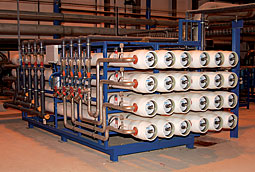
Reverse Osmosis and Nanofiltration"HydroTech Engineering" Co Ltd applies Reverse Osmosis systems for providing partial water desalination. Reverse Osmosis is used for: filling and feeding of cooling circuits; feeding of steam boilers; technological processes of various enterprises; purification of drinking water for the food industry. Reverse Osmosis is an effective technological process that can provide partial water desalination. The main factor of Reverse Osmosis is applied pressure. The higher the saline content in the solution, the greater the specific energy consumption for desalinated water. Reverse Osmosis is most effective when the saline content of the water is more than 500 ppm. As a result, there are two flows along the membrane: a permeate, that passes through the membrane creating partially desalinated water; and a concentrate, consisting of a concentrated solution of the original saline levels. Inhibitors are used for prevention of fouling of poorly soluble salts on the membrane surface. Prevention of microbial contamination of the membrane surface is accomplished by the introduction of the raw water which has been treated and then dosed with biocides. Biocides are used for prevention of microbial contamination on the membrane surface. Permeate recovery rate varies from 30% for sea water desalination to 80% for low saline content water desalination. It is necessary to use additional Reverse Osmosis plants in order to increase permeate output.
Suspended solids, colloids and strong oxidants should be removed from raw water for the effective and continuous operation of the reverse osmosis plant. Thus, pretreatment must be implemented for raw water. The ideal solution for this kind of pretreatment is ultrafiltration technology. The high quality of the feed water significantly increases the efficiency and working lifespan of the membrane elements, resulting in a significant reduction of operating costs. Modern Reverse Osmosis membranes are made of polyamide materials. A wide range of materials and methods for their preparation allows the introduction of a wide range of Reverse Osmosis membranes:
The variety of membrane types and their various configurations allows to achieve the required characteristics of desalinated water from any quality feed water. Advantages Reverse Osmosis has many advantages to classical methods of water treatment:
All systems and installations are developed individually; this allows the manufacturing of all types of water treatment systems. Reverse Osmosis reduces saline content and the accumulation of organic substances (almost complete removal of oxidation, COD, BOD and so on). |




